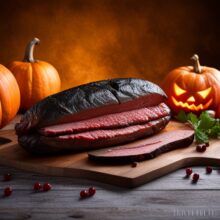Smoked Beef Rubs
A good rub can enhance the flavor of your smoked beef. Let’s talk about some different rubs you can use for your beef!
Beef rub is a bit different than pork rub. Pork prefers a rub with more sugar in it, while beef doesn’t.
Salt
Adding a pinch of smoked salt to your meat rubs can add a delicious smoky flavor to the final dish. It can also help to balance out the flavors and add a nice texture to the dish.
You can use smoked sea salt for all kinds of cooking, including barbecue recipes. It can be sprinkled on steaks, roasted vegetables, and even grilled cheese sandwiches to give them a smoky flavor.
Smoked beef rubs can also draw out moisture from the steak, making it more tender. This makes it a great way to treat yourself or your friends to a juicy steak.
You can also add a bit of smoked salt to your desserts, such as caramel ice cream. It will make them taste better, too! It’s an easy, inexpensive way to add more flavor to your dishes.
Sugar
Smoked beef rubs are a fantastic way to add intense flavor to your meats. They’re also easy to make and store for a long time.
Sugar is a key ingredient in dry rubs because it’s one of the main ingredients that helps to brown and caramelize meat. It’s also a great sweetener and helps to balance out the salt and pepper in the mix.
Aside from sugar, salt is another important ingredient in smoked beef rubs. It intensifies the flavors of other spices, and it helps to reduce bitterness.
The best dry rubs for smoked beef are seasoned with a combination of salt, sugar, and savory spices like garlic or onion powder. Adding a little bit of a kick to the mixture with a few hot spices, like cayenne or chili powder, can make your rub even more delicious.
To use this dry rub on a beef rib rack, sprinkle the entire surface of the rack with the mixture. You can do this before you smoke the meat, or it will keep for a while in the freezer.
Dry Brine
Dry brining is a much easier way to make your meat juicier, more flavorful and more tender than traditional wet brines. It works well with lean cuts of beef that often get a bit dry during cooking and also is useful with pork, lamb, and poultry.
Dry salting involves sprinkling your favorite rub evenly over the surface of your meat, then leaving it in the fridge overnight to let it absorb the liquid. Depending on how much moisture is drawn out by the salt, this could take up to 24 hours for chicken and 48 to 72 hours for turkey.
When the dry brining process is complete, it is usually a good idea to pat your meat dry and then rub it with a dry seasoning before cooking. The dry brining process makes it easier for your rub to adhere to the meat’s surface and form a crust during the smoking process.
This dry seasoning method is also an easy way to improve water-chilled boneless skinless chicken breasts, as Cook’s Illustrated magazine explains. It won’t help a lot with enhanced meat (Butterball self-basted turkey, Swift Premium Guaranteed Tender Pork), as those already receive a wet brine treatment by the manufacturer.
Wet Brine
Wet brining is a popular method to season and tenderize meat. It involves submerging meat in a salt water solution for several hours before cooking.
Brine can be made with a variety of aromatics and herbs. Bay leaves, peppercorns, garlic, whole allspice, hearty herbs (rosemary and thyme are good options), and citrus zest are common additions to wet brines.
Brining is a time-honored cooking technique that adds flavor and helps foods retain moisture during cooking. It seasones and moistens uncooked foods, and it improves protein-rich foods in particular, which can dry out over high heat.
There are two main types of brining: wet and dry. Wet brines, which are a popular method of brining turkeys, use saltwater to saturate and retain meat’s moisture.
Read more great BBQ articles at Bob's BBQ Tips



